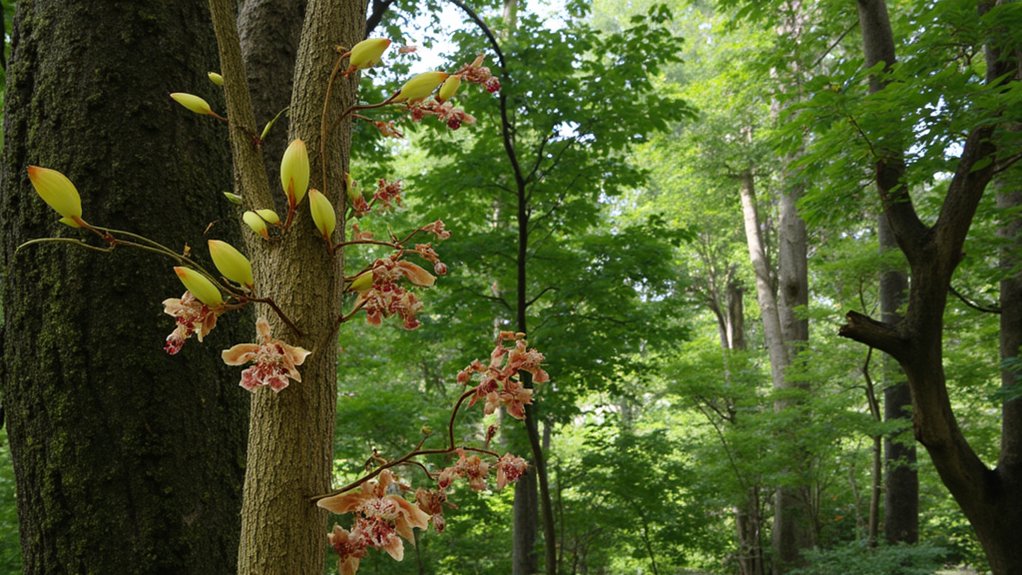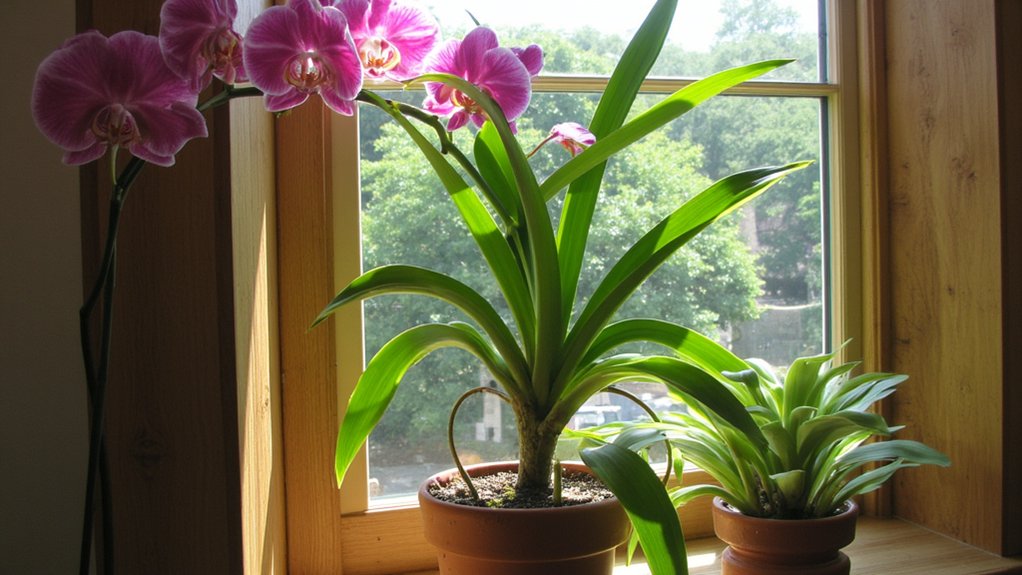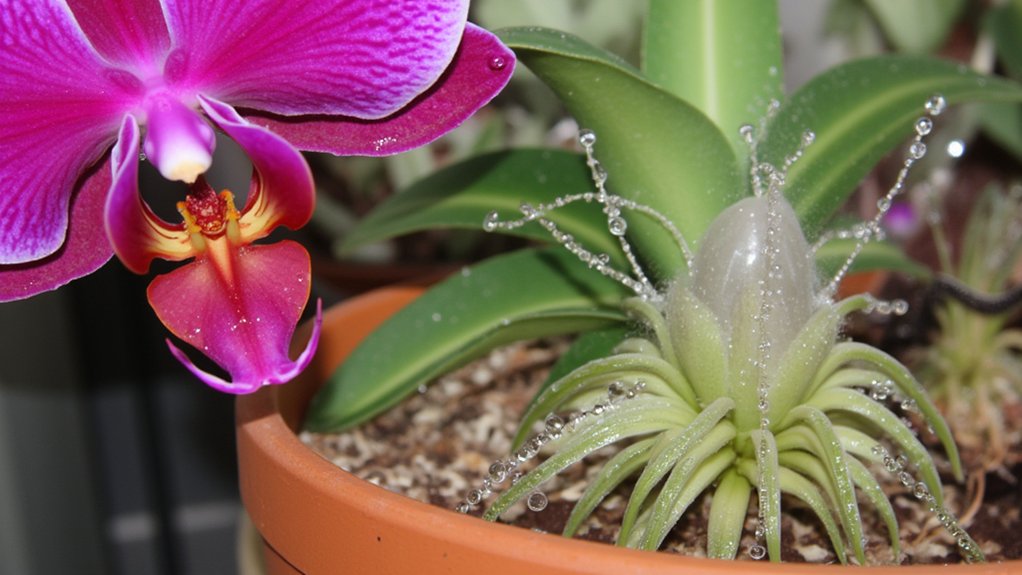If you’re deciding between orchids and bromeliads for your indoor garden, you’ll want to understand their distinct care requirements before making your choice. These exotic beauties offer dramatically different growing experiences, with one requiring precise attention to detail and the other thriving on near neglect. Your success with either plant depends largely on your gardening style and time commitment, but there’s more to reflect upon than just maintenance levels.
Contents
- 1 Natural Habitats and Origins
- 2 Light Requirements and Growing Conditions
- 3 Watering Patterns and Humidity Needs
- 4 Soil Types and Potting Methods
- 5 Blooming Cycles and Flower Duration
- 6 Common Pests and Disease Management
- 7 Propagation Techniques and Growth Rates
- 8 Essential Tools and Maintenance Equipment
Natural Habitats and Origins

While both orchids and bromeliads can be found in tropical regions, their native ranges differ markedly. You’ll discover orchids growing naturally across six continents, from the humid rainforests of Southeast Asia to the temperate woodlands of Europe and North America.
Bromeliads, on the other hand, are primarily native to the Americas, with most species originating in the tropical and subtropical regions of South America. You’ll find them thriving in diverse environments, from the canopy of the Amazon rainforest to the arid deserts of Chile, where they’ve adapted to growing on trees, rocks, or soil.
Light Requirements and Growing Conditions

Although both plants need light to thrive, orchids and bromeliads have distinctly different lighting requirements for ideal growth. You’ll find that most orchids prefer bright, indirect light for 12-14 hours daily, while bromeliads can handle more varied light conditions.
For orchids, place them 3-5 feet from an east-facing window, or behind a sheer curtain on southern exposures. They’ll show yellowing leaves if there’s too much light. Bromeliads, however, can adapt to both low and bright indirect light, though they’ll produce more vibrant colors with 4-6 hours of moderate sunlight daily.
If you’re using grow lights, position orchids 6-12 inches below, and bromeliads 12-18 inches away.
Watering Patterns and Humidity Needs

Because orchids and bromeliads originate from different natural habitats, they require distinct watering approaches for excellent growth. You’ll need to water orchids thoroughly once every 7-10 days, allowing their roots to dry slightly between waterings. For humidity, maintain levels around 50-70% for optimal health.
With bromeliads, you’ll want to fill their central cup, or tank, with water and keep it partially full at all times. Unlike orchids, they absorb moisture primarily through this central reservoir. You should flush the cup with fresh water monthly to prevent stagnation, while maintaining humidity levels between 60-80% for best results.
Soil Types and Potting Methods
Since orchids and bromeliads have distinct root structures, they need completely different potting mediums to thrive. You’ll want to plant orchids in a chunky, bark-based mix that allows air to circulate around their roots, while bromeliads prefer a well-draining potting soil enriched with organic matter.
For orchids, use a container with plenty of drainage holes and fill it with medium-grade orchid bark, adding some perlite and charcoal. When potting bromeliads, choose a pot that’s 1-2 inches wider than the plant’s base, using a mix of two parts peat moss to one part perlite and one part coarse sand.
Blooming Cycles and Flower Duration
The proper soil and potting setup helps create ideal growing conditions, but the real magic happens during blooming season. Orchids typically bloom once or twice yearly, with flowers lasting 2-3 months, while bromeliads produce a single dramatic bloom that persists for 3-6 months.
You’ll find that orchids can rebloom on the same spike if you trim it properly above a node. Bromeliads, however, die after flowering but produce offshoots called “pups” that will bloom in 1-2 years.
Timing varies by species, but you can expect orchids to flower between winter and spring, while bromeliads may bloom any season depending on maturity and care.
Common Pests and Disease Management
While both orchids and bromeliads face similar pest challenges, you’ll need distinct management strategies for each plant type. Orchids are particularly susceptible to spider mites and mealybugs, which you can combat using neem oil spray every 7-10 days. Watch for yellow spots and webbing as early warning signs.
Bromeliads mainly battle scale insects and mosquito larvae that breed in their water-filled centers. You’ll want to flush the central cup monthly and treat scale with rubbing alcohol on a cotton swab. For both plants, maintaining proper air circulation and avoiding overwatering will prevent most fungal diseases, including root rot and leaf spot.
Propagation Techniques and Growth Rates
Growing orchids and bromeliads requires distinctly different propagation approaches based on their natural reproduction methods. You’ll find orchids multiply through division of pseudobulbs or keiki growth, while bromeliads produce offsets called “pups” from their base.
For orchids, you can separate mature pseudobulbs with at least three healthy growth nodes during repotting season. Bromeliads are easier – just wait until the pups reach 1/3 the size of the mother plant, then cut them off at the base with sterilized tools.
Growth rates vary considerably. Orchids typically take 3-7 years to reach blooming size, whereas bromeliad pups mature in 1-2 years.
Essential Tools and Maintenance Equipment
Successful propagation and growth depend heavily on having the right tools at your disposal. For orchids, you’ll need sharp pruning shears, a moisture meter, and a specialized potting mix scoop. Bromeliads require fewer tools – mainly a spray bottle and small trowel.
Both plants benefit from having clean 6-inch pots, sterilized cutting tools, and a digital hygrometer to monitor humidity. You’ll also want a water quality tester to maintain proper pH levels between 5.5-6.5.
Store your tools in a dry area, and always sanitize them with 70% isopropyl alcohol between uses to prevent disease transmission between plants.
